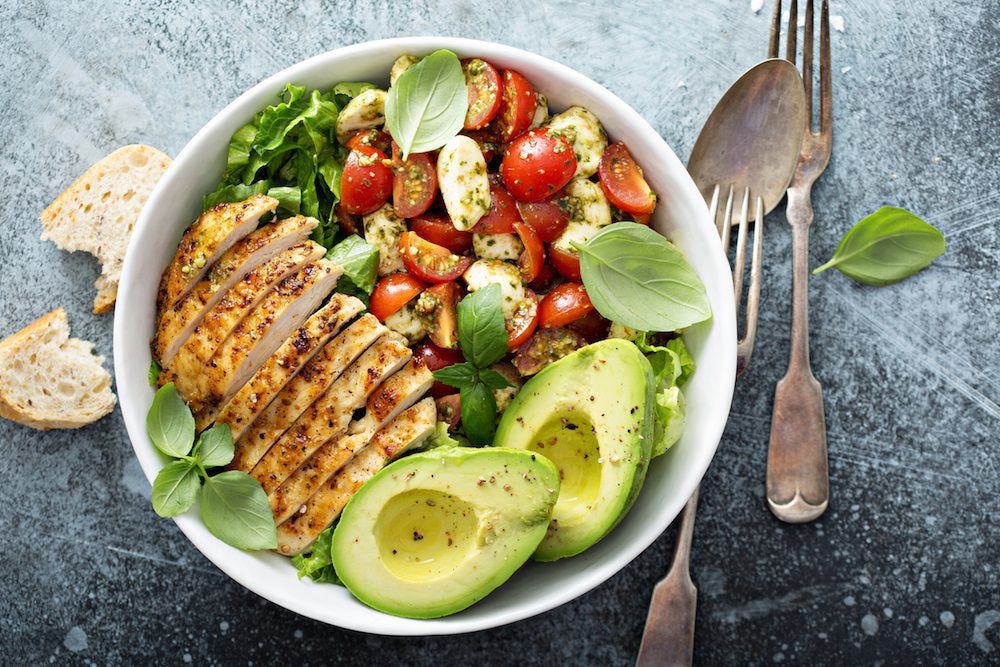How to Make a Salad You’ll Actually Want to Eat
Often hailed as the epitome of healthy eating, salads are a great way to get more veggies into your diet. Unfortunately, they’re often bland, which doesn’t make them very exciting to eat.
What you might not know about salads is there are many ways to make them hearty, filling, and enjoyable – you don’t have to settle for flavorless lettuce drowned in dressing! Here are some healthy ways to spice up your salads by adding more variety and flavor.
Core Components of a Healthy Salad
To optimize your salads, it’s best to include a variety of flavors and textures. For example, a salad that’s only romaine lettuce and ranch dressing will get boring quickly compared to a salad with romaine, seasoned grilled chicken, shreds of parmesan cheese, crunchy red onions, and tangy olive oil and vinegar dressing.
You may think your greens-only salad is healthy because it’s loaded with polyphenols and other healthy nutrients. But to really get the most out of what salads can offer nutritionally, you’ll want some protein and healthy fats in there, too. This will help create a balanced meal to keep you full longer than if you just ate a salad completely made up of lettuce.
Healthy Bases for Salads

The best salad is the one you’ll enjoy eating and that appeals to your taste buds. Additionally, you’ll get more nutrition out of a salad if you opt for dark leafy greens.
A blend of light and dark greens is fine if you aren’t keen on the taste of darker greens. Below are some all-star greens that are nutritious bases for a salad.
Spring Mix
You can find spring mix salad blends at most supermarkets. Though there are many different blends among various brands, they often contain greens such as green leaf lettuce, radicchio, baby spinach, red romaine, and arugula.
This blend has more flavor than lighter lettuces such as romaine, but is still mild in flavor, making it an excellent base that pairs well with white meats, dried fruits, and vegetables like shredded carrots.
Spinach and Arugula
Spinach and arugula go well together, too. Arugula is known for its “peppery” flavor; it has a slight bite to it that makes it great in salads. Adding a small amount goes a long way, and it doesn’t overpower the mild flavor of spinach.
Arugula has folate, magnesium, potassium, and vitamins C and K. Spinach has calcium, iron, and vitamin A. A recent study found that these nutrients may help strengthen the immune system and combat the effects of stress.
Massaged Kale
Kale is an excellent source of many vitamins and minerals, including, calcium, copper, potassium, and vitamins A, C and K. It also has lots of fiber and can promote healthy digestion. It has a strong flavor, and goes well with milder greens like spinach or romaine.
If the flavor of kale is too strong for your preference, you can opt for baby kale instead – the younger kale plant is much milder.
One of my favorite ways to enjoy kale is to massage it by hand with avocado, a little fresh lemon juice, and a dash of salt and pepper. It’s so simple and easy, and massaging the kale not only softens the texture, but also takes away some of the bitterness in the leaves.
Healthy Toppings for Salad

There are endless options when it comes to salad toppings. It’s great to be creative and keep trying new things, otherwise you can get stuck in a rut and give up on salads altogether, which means you’ll miss out on all their health benefits.
Here are some unique ideas for healthy salad toppings.
Healthy Protein Sources
One way to transform your salad from a uninspired dish that leaves you feeling hungry in an hour to a filling and satisfying meal is to add plenty of protein. Protein helps you feel full longer and is important for healthy skin, hair, and many of the body’s processes.
- Roasted chickpeas
- Baked or grilled chicken
- Hemp hearts
- Boiled eggs
- Tuna
- Quinoa
- Lentils
- Shrimp
- Black beans, kidney beans
Healthy Fruit Options
Fruits are often left off salads, but they’re one of the ways you can make salads more interesting. Combining sweet or tart fruits with savory items in salads can create dynamic, rich flavors that will make you look forward to eating your salad.
- Dried fruit: dried cherries, cranberries, or apricots are a good source of fiber and can add some sweetness and texture to your salad. Make sure to opt for dried fruits that don’t have sugar added – the USDA recommends limiting sugar to less than 10% of your total daily caloric intake.
- Fresh strawberries, blackberries, or blueberries: these are full of antioxidants that help your body combat the effects of stress. They pair well with feta cheese and spinach.
Healthy Fats
Fats add flavor, and most of the options below also have additional protein, vitamins, and minerals. Adding protein and healthy fats to your leafy greens will make it a meal that’s more satisfying and keeps you full throughout the afternoon or evening.
- Avocado
- Olive oil (paired with vinegar as dressing)
- Nuts (walnuts, almonds, cashews)
- Seeds (sunflower seeds, pumpkin seeds)
Healthy Veggies
Vegetables can add color, fiber, vitamins, and minerals to your salad. They also enhance the flavor profile of your salad. With so many different veggies to choose from, you can ensure that your salad always has new and fresh flavors.
- Carrots (shredded or sliced)
- Broccoli
- Red or white onion
- Cucumbers
- Bell peppers, banana peppers
- Brussels sprouts
- Sliced radishes
- Mushrooms
- Olives
Healthy Dairy Options
Dairy can be a great way to add more protein, calcium, and flavor to salads. Most salads that have dairy offer it in the form of cheese. Adding small amounts of cheese can make salad even more delicious. Try these cheese options:
- Feta cheese
- Parmesan cheese
- Blue cheese
- Goat cheese
- Parmigiano Reggiano
Recipes to Get You Started
Now that you know how to construct a healthy salad and some ways to change things up, here are some recipes to help you start making amazing salads:
- Greek Salad
- Massaged Kale Salad with Roasted Chickpeas
- Healthy Taco Salad
- Quinoa Salad
- Mediterranean Lentil Salad
- Vegan Cobb Salad
Final Thoughts
As you can see, there are many ways to spruce up your greens, and eating salads doesn’t have to be boring or mundane. With a little creativity, you can build salads that please the palate and help you look forward to eating your veggies.
Any time you start a new habit, remember that it’s okay to take one step at a time. It can be overwhelming to make too many changes all at once, so try adding one or two new items to your salads, or simply switch out your greens for starters.
Happy salad making!
At BrainMD, we’re dedicated to providing the highest purity nutrients to improve your physical health and overall well-being. For more information about our full list of brain healthy supplements, please visit us at BrainMD.
- Good vs. Bad Carbs: How to Create a Balanced Diet with Healthy Carbs! - January 27, 2022
- How to Make Homemade Salad Dressings + Recipes! - August 28, 2021
- How to Ditch Diet Culture & Improve Your Relationship with Food - August 25, 2021




All of this is wonderful!! I believe and trust Dr. Amen. My issue is, I am 82 and was wondering is there recipes for making smoothies? I have a brain injury and had a stroke. I need to buy or make something easy for myself. I am overwhelmed easily. Are there pre made smoothies for veggies, with pure ingredients to suggest? Thank you in advance.